2. 中国科学院南京地理与湖泊研究所/湖泊与环境国家重点实验室, 江苏 南京 210008
2. Nanjing Institute of Geography and Limnology, Chinese Academy of Sciences/State Key Laboratory of Lake Science and Environment, Nanjing 210008, China
以太湖为中心的太湖流域, 北临长江, 南靠杭州湾, 东临东海, 西接天目山、宜漂山区。湖区共有215条出入湖河流, 大致分为运河水系、苕溪水系和宜溧河水系及出湖水系。其中江苏省占53%, 浙江省占33.4%, 上海市占13.5%, 安徽省占0.1%, 流域总面积达36 500 km2。近20 a来, 随着经济快速发展, 人口持续增长,城市不断扩张, 使得太湖流域水资源利用强度加大, 同时大量的工业废水、农田径流、生活污水进入河流, 向河流输入了大量重金属和营养盐物质, 严重影响了流域居民的生活及工农业生产[1-3], 太湖流域的水环境面临空前压力, 引起社会各界的高度重视。在水环境中, 重金属元素不能被微生物降解, 相反却可能被生物富集及放大, 具有隐蔽性、长期性和不可逆转性等污染特征[4-7]。目前, 国内外关于太湖沉积物重金属污染特征的研究较多, 但大多仅局限于湖体本身[8-11], 关于整个流域重金属分布特征的报道鲜见。
选取太湖流域及湖体共98个采样点, 通过测定太湖流域水体和表层沉积物中Cr、Cu、Zn、As、Cd、Pb和Hg 7种重金属含量, 揭示太湖流域重金属的时期变化及空间分布。探讨了不同时期各水系对湖体重金属污染的贡献作用, 并分析了沉积物中这7种重金属的潜在生态危害指数, 以及沉积物与水体这7种重金属的分配特征, 评价太湖流域重金属的潜在生态危害, 旨在为太湖流域重金属污染的综合治理提供科学依据。
1 材料与方法 1.1 采样点的布设为聚焦重金属污染对太湖流域的贡献作用, 采样点的布设体现了不同水系圈层特征(湖体-湖滨带-上游入户湖荡河网区-水源涵养区等)及水生态类型的空间差异性因素。共布设98个采样点位。其中太湖湖体20(TH1~TH20) 个, 运河水系26(YH1~YH26) 个, 苕溪水系12(SX1~SX12) 个, 宜溧河水系10(YL1~YL10) 个,出湖水系30(CH1~CH30) 个, 具体采样点如图 1。
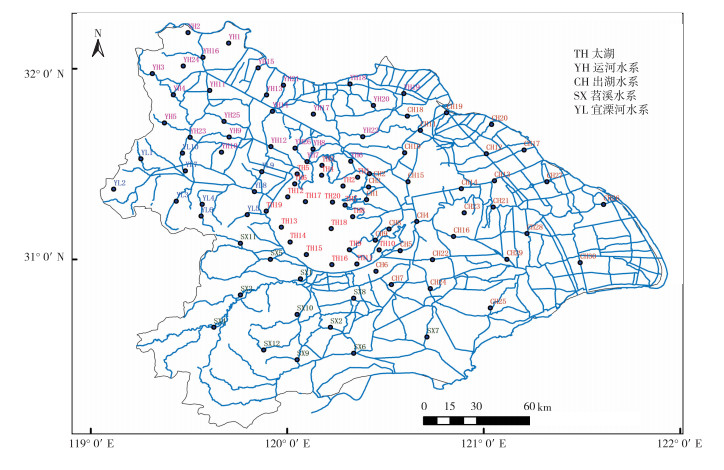
|
图 1 太湖流域水样和沉积物采样点 Figure 1 Distribution of surface water and sediments sampling sites in the Lake |
2012年11月至2013年8月在太湖流域定点采集了枯水期(2012年11月)、平水期(2013年4月)和丰水期(2013年8月)3个时期的样品。各采样点采集1 L水样于聚乙烯塑料瓶中, 并用彼得森采集器采集0~3 cm表层沉积物, 装入密实聚乙烯塑料袋。
水样运回实验室后立即进行硝酸(pH值<2) 处理, 同时用0.45 μm孔径微孔滤膜过滤, 4 ℃条件下保存待进行可溶性微量元素分析。沉积物运回实验室后放入-20 ℃冰箱中冷冻保存, 取200 g样品冷冻干燥, 剔除杂物, 用研钵磨碎过0.147 mm孔径筛后用密实袋封装待用。样品的采集、运输、保存参照《湖泊富营养化调查规范》。
1.3 样品测试沉积物样品在硝酸-氢氟酸-高氯酸及Berghof MWS-3微波消解系统中反应待测。Cr、Cu、Zn、As、Cd和Pb含量采用电感耦合等离子体质谱仪(ICP-MS 7700x, 美国)测定, Hg含量采用CVAAS方法(Hydra-C直接汞分析仪, 美国)测定。
1.4 数据分析采用潜在生态风险指数法评价太湖流域沉积物重金属污染程度[12]。Er,i为单一重金属潜在生态风险参数, IR为多种重金属潜在生态风险指数。潜在生态风险指数等级划分如表 1所示[9]。
|
|
表 1 潜在生态风险指数等级划分 Table 1 Grading of potential ecological risk indices |
Er,i和IR的计算公式如下:
| $ {C_{{\rm{f, }}{i}}} = {C_{{\rm{D}}, i}}/{{C}_{{\rm{R, }}{i}}}, $ | (1) |
| $ {E_{{\rm{r}}, {i}}} = {T_{{\rm{r}}, i}} \times {{C}_{{\rm{f, }}{i}}}, $ | (2) |
| $ {{I}_{\rm{R}}} = \sum {{E_{{\rm{r, }}{i}}}}。$ | (3) |
式(1)~(3) 中,Cf,i为某一金属的污染参数; CD,i为沉积物中重金属的实测含量, mg·kg-1; CR,i为计算所需的参比值(采用江苏省土壤重金属背景值作为参比); Er,i为单一重金属潜在生态风险参数; Tr,i为单一重金属的毒性响应参数(Cr、Cu、Zn、As、Cd、Pb和Hg的毒性响应参数分别为2、5、1、10、30、5和40); IR为多种重金属潜在生态风险指数。
采用金属的分配系数lgKd值来评价重金属在水相和颗粒物之间的迁移能力及可能的潜在生态危害。分配系数的表达式为:
| $ {{K}_{\rm{d}}} = {C_{\rm{s}}}/{C_{\rm{v}}}。$ | (4) |
式(4) 中, Cs和Cw分别为体系达平衡状态时固相(沉积物)和液相(溶解态)中重金属含量, mg·kg-1。
采用SPSS 20.0和Origin 8.0软件处理分析数据, 用Acrgis 9.3软件作图。
2 结果与分析 2.1 太湖流域水体重金属的分布特征从图 2可知, 7种重金属浓度从大到小依次为Zn、As、Cu、Cr、Pb、Hg和Cd, 均没有超过GB 3838—2002《地表水环境质量标准》Ⅰ类标准。平水期水体ρ(Cr)和ρ(Cu)分别达1.26和4.27 μg·L-1, 均高于枯水期和丰水期。ρ(Zn)和ρ(As)则以丰水期为最大, 达18.11和3.63 μg·L-1。ρ(Cd)、ρ(Pb)和ρ(Hg)稳定, 没有显著的时期变化。从全年均值上看, 运河水系ρ(As)、ρ(Cd)、ρ(Cr)、ρ(Cu)和ρ(Hg)均显著高于其他水系(图 2, P<0.05), 其中ρ(Cr)为其他水系的5倍以上, ρ(Cu)、ρ(As)和ρ(Cd)均为其他水系的2倍左右。苕溪水系ρ(Pb)显著低于其他水系(P<0.01)。太湖各重金属含量处于中等值。
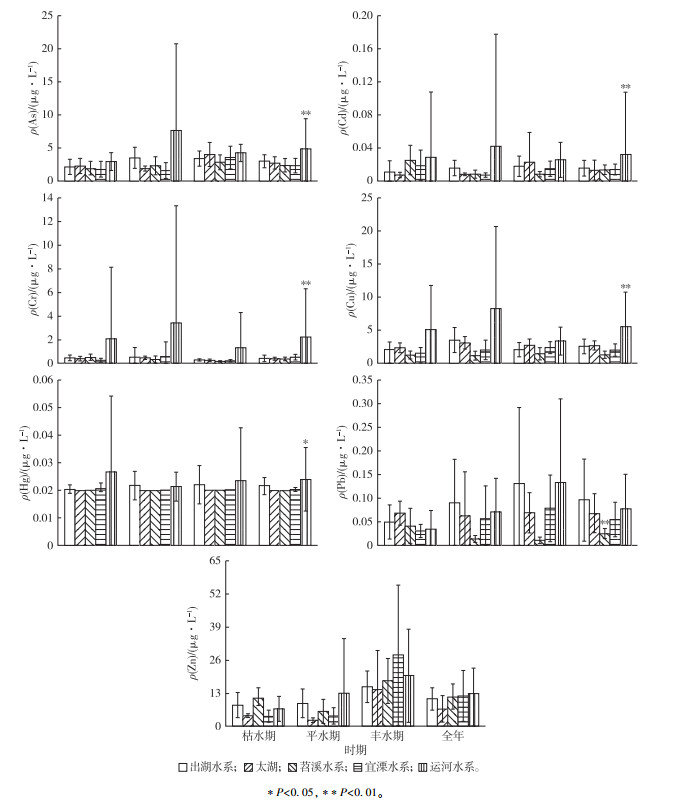
|
图 2 各水系水体中重金属浓度随时间的变化 Figure 2 Temporal variation of heavy metal concentrations in the water systems |
在107个监测点位中Cr浓度高于地表水环境质量一类标准的有4个点位, 最高超标4.6倍, 主要位于运河水系上。Cu超标点位为10个, 最高超标为6.5倍, 主要位于运河水系上。Zn超标点位只有4个, 最高超标约2倍, 主要分布于运河水系、宜溧河水系及太湖。图 3为太湖流域水体中Cr、Cu、Zn和As这4种重金属在枯水期、平水期及丰水期的空间分布, 由于Cd、Hg和Pb含量在流域中普偏极低, 未列出。从图 3明显看出, 重金属超标点位主要分布在工业发达的常州、无锡、苏州等地。从水系划分来看, 运河水系和出湖水系这4种重金属含量远远高于宜溧河水系以及山区苕溪水系。这2条水系中发达的航运、东部湖区的养殖业、北部城镇和工业区的工业及生活污水, 特别是金属电镀污水排放, 对引发重金属污染影响极大。湖泊沉积物可以通过水生植被的生物化学过程将排放到水体中的重金属吸附, 腐败后在底泥中沉积和富集, 造成持续的、潜在的危害[13-14]。
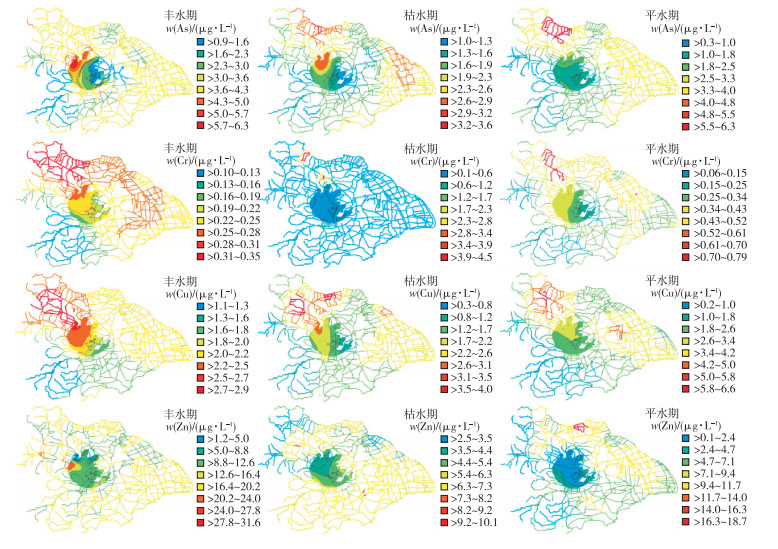
|
图 3 水体中4种重金属浓度时空分布特征 Figure 3 Temporal and spatial distribution of four heavy metal concentrations in surface water |
沉积物中7种重金属含量从大到小依次为Zn、Cr、Cu、Pb、As、Hg和Cd(图 4), 这与7种重金属元素在地壳上的丰度值相一致, 说明太湖流域沉积物中各重金属元素的分布主要受地壳元素分布的控制。由于缺乏太湖流域沉积物中重金属的背景值, 目前也没有明确的沉积物环境质量标准, 因而把测定结果与中国土壤环境质量一级标准进行比较, 发现Cr、Cu、Zn、Cd、Pb元素均超过标准值, 其中Cd超标最为严重, 达到标准的4.7倍; As和Hg只有标准值的65.8%和71.3%。
从全年均值(图 4)上看, 沉积物中出湖水系和运河水系Cu含量显著高于其他水系(P<0.01), 太湖水系和苕溪水系As含量显著高于其他水系(P<0.01)。运河水系和出湖水系沉积物中Cr、Cu、Pb含量明显超出标准值, 而其他水系低于或者接近标准值。沉积物中Zn含量较高的为出湖水系和运河水系, 而Cd含量较高的为宜溧河水系和太湖。沉积物中Cr、Cu、Zn、Pb超标点主要位于运河水系和出湖水系(图 5), 这里人口密集,工业发达。太湖西部的宜溧河水系沉积物中Cd超标, 这里主要包括南京高淳、溧水, 常州溧阳, 无锡宜兴等地。而沉积物中As和Hg含量较高, 没有明显的水系区分, 这可能主要受地壳含量的影响。太湖流域Cr、Cd、Cu、Pb含量明显高于国内其他流域, 如巢湖、海河和辽河流域(表 2[15-17])。
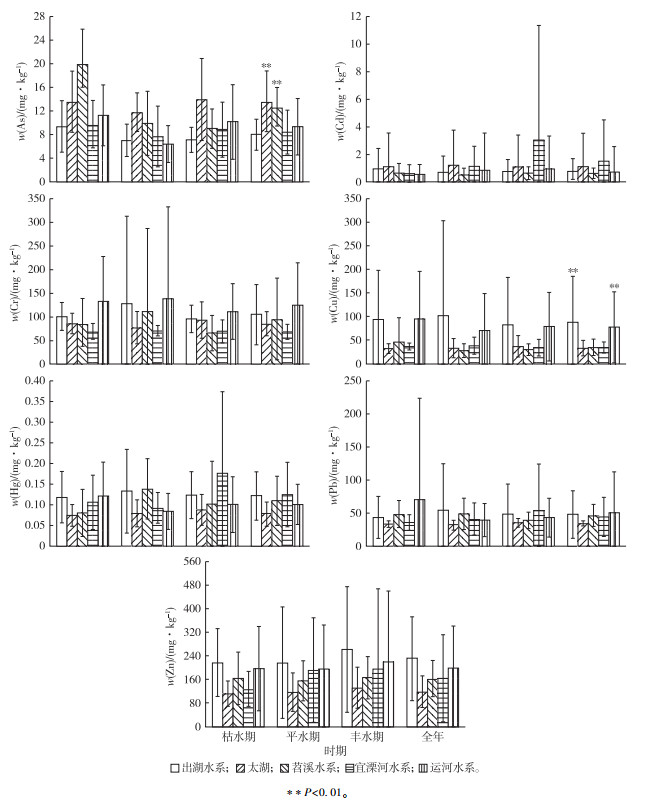
|
图 4 各水系沉积物中重金属浓度变化 Figure 4 Variation of heavy metal concentrations in sediments of the water systems |
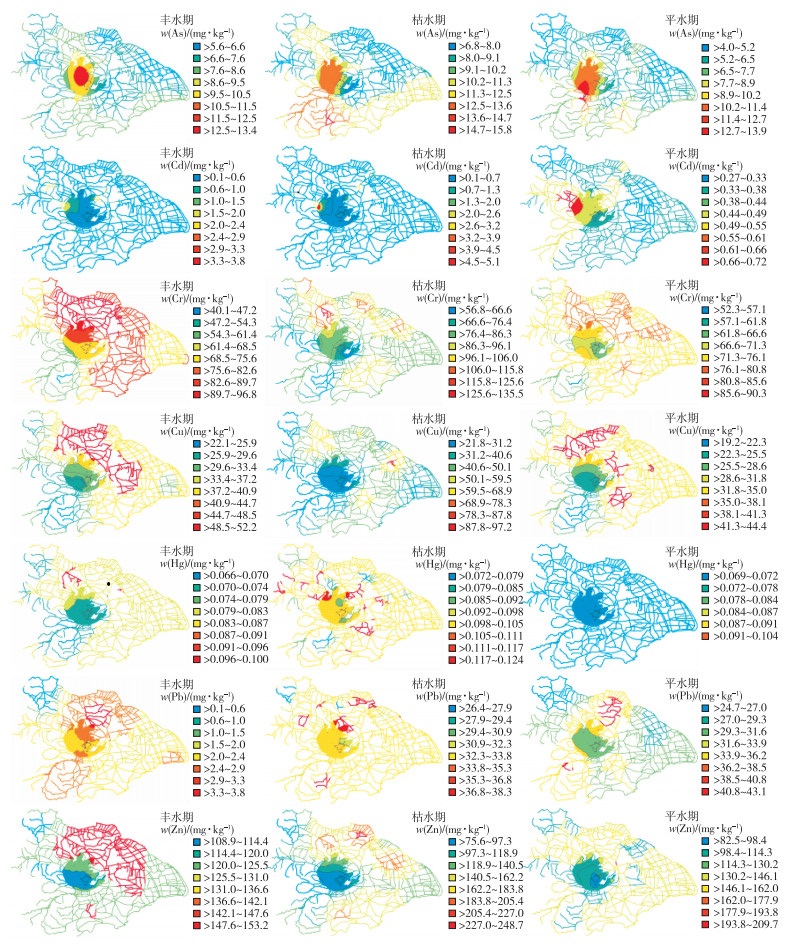
|
图 5 沉积物中7种重金属含量的时空分布特征 Figure 5 Temporal and spatial distribution of the seven heavy metal concentrations in the sediments |
|
|
表 2 国内主要流域重金属含量 Table 2 Contents of studied metals in major basins of China |
太湖流域沉积物中重金属超标会引发潜在的生态危险, 通过计算单一元素生态风险指数(Er,i)和综合生态风险指数(IR)可以评价太湖流域沉积物重金属的生态风险。如表 3所示,太湖流域沉积物中7种重金属的Er,i值大小顺序为Cd> Hg> Cu> As>Pb> Cr> Zn, 其中Cd是最主要的生态风险贡献因子, 太湖水系和宜溧河水系Cd的Er,i值分别达169.06和225.17, 风险程度为生态危害很强, 出湖水系、苕溪水系和运河水系为生态危害中等。尽管太湖流域沉积物中Cr、Zn、Pb、Cu均超标, 但生态危害较低, 不是主要的生态风险因子。Hg虽然没有超过标准值, 但其生态影响较强, 成为太湖流域仅次于Cd的主要生态风险贡献因子。
|
|
表 3 太湖流域沉积物单一元素生态风险指数(Er,i)和综合生态风险指数(IR) Table 3 Potential ecological risk factor, and integrated ecological risk index of each individual heavy metal element in the sediment of the Lake Taihu Basin |
宜溧河IR值为278.13, 属于重生态危害。出湖水系、太湖、苕溪水系和运河水系均为中等生态危害, IR值分别为175.54、211.75、146.24和166.88。对比邴海健等[18]对西氿、毛志刚等[9]对东太湖进行的潜在生态风险评价结果发现, 2010年西氿各重金属的Er,i值均大于该研究中的宜溧河水系, 说明经过多年的治理, 生态风险确呈下降趋势。2014年东太湖Cr、Cd、Pb、Hg的Er,i值均明显低于该研究结果, 说明草型湖区生态系统结构和功能的完善将有助于降低水环境的重金属潜在生态风险[9]。
2.3.2 太湖流域沉积物与水体重金属的分配系数污染物质在颗粒物-水相间的分配系数指在水-颗粒物两相体系达平衡状态时, 污染物在颗粒物和水中浓度的比值是描述污染物质在水环境中行为的重要物理化学特征参数。直接计算天然水体物理化学条件下污染物在沉积物-水间的分配系数, 更能反映污染物质在水相和颗粒物相间的迁移能力及可能的潜在生态危害[19]。表 4和图 6统计了不同时期太湖流域及各水系中7种重金属在固-水两相中的分配系数。
|
|
表 4 太湖流域不同时期水体沉积物中重金属分配系数 Table 4 Partition coefficients (lg Kd) of the heavy metals between water and sediment of the Lake Taihu Basin relative to water season |
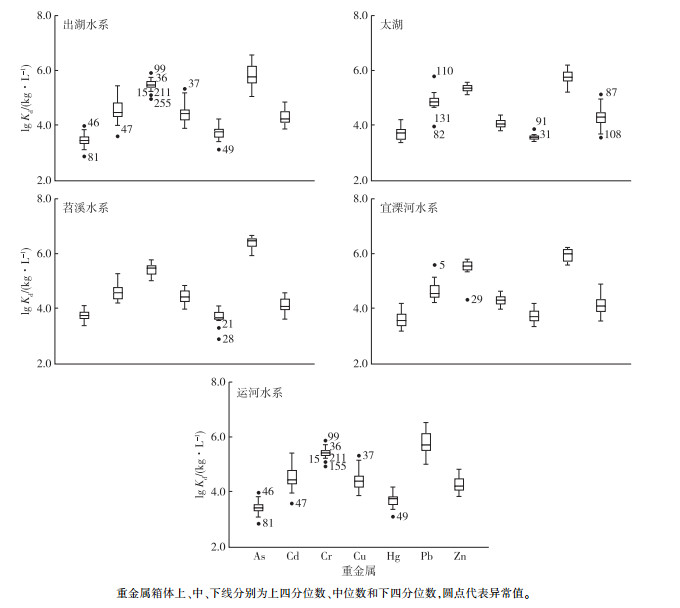
|
图 6 各水系中重金属分配系数 Figure 6 Partition coefficient of heavy metals between different water systems |
分析结果表明, 各重金属在水体和沉积物中的分配系数均不相同, 原因可能是各元素化学性质和吸附特征各不相同, 从而造成各污染物在两相中分配的差异。平水期时, Cr、Cu分配系数明显低于枯水期和丰水期, Zn、As、Cd、Pb在丰水期时分配系数低于枯水期和平水期, 因而存在较大的生态危害。Cr、As、Cd、Hg这4种重金属的分配系数在运河水系最低, 而Cr、Cu、As、Pb这4种重金属分配系数在太湖西南部山区的苕溪水系中最大。相比太湖流域其他水系, 苕溪水系受人为干扰较少, 水体扰动较小, 而运河水系承担着水利运输功能, 受人类活动影响较大, 水体扰动明显增大, 这导致重金属分配系数的改变。总体上, 各重金属的分配系数与水量及水体扰动存在明显关系, 丰水期水量充足, 使得重金属分配系数降低, 同时人为扰动的增加加强了重金属潜在的生态危害。
3 结论(1) 太湖流域7种重金属含量年均值均未超过GB 3838—2002《地表水环境质量标准》一类标准, 水环境质量较好。不同水期偶有超标现象, 超标点位主要分布在工业发达的常州、无锡、苏州等区域。从水系划分来看, 运河水系和出湖水系Cr、Cu、Zn和As 4种重金属含量远高于宜溧河水系以及山区苕溪水系, 这与水系发达的航运, 东部湖区的养殖业, 北部城镇和工业区的工业及生活污水, 特别是金属电镀污水排放等因素息息相关。
(2) 太湖流域沉积物Cr、Cu、Zn、Cd、Pb含量年均值均超出GB 15618—1995 《土壤环境质量标准》一类标准。其中Cd超标最严重, 为标准值的4.7倍。Cr、Cu、Zn、Pb超标点位主要位于运河水系和出湖水系; Cd超标点位主要位于太湖西部的宜溧河水系; As和Hg含量普遍较高。此外, 太湖流域Cr、Cd、Cu、Pb含量常年均值明显高于巢湖、海河和辽河等流域。
(3) 太湖流域沉积物中7种重金属的潜在生态风险因子从大到小依次为Cd、Hg、Cu、As、Pb、Cr和Zn。Cd是最主要的生态风险贡献因子, 这与其严重超出标准值密切相关, 在太湖流域各水系中, 其生态风险参数极高, 存在较高的生态危害。尽管太湖流域沉积物中Cr、Zn、Pb、Cu均超标, 但由于其相对低的生态影响使其在太湖流域沉积物中并不是主要的生态风险因子。而沉积物中Hg含量没有超过标准值, 但其较强的生态影响, 使其成为太湖流域沉积物中仅次于Cd的主要生态风险贡献因子。从多种金属潜在生态风险指数来看, 宜溧河水系生态风险指数为278.13, 属于重生态危害, 而其他水系处于中等生态危害水平。
| [1] |
ZOUMIS T, SCHMIDT A, GRIGOROVA L, et al. Contaminants in Sediments:Remobilisation and Demobilisation[J]. Science of the Total Environment, 2001, 226(1/2/3): 195-202. (  0) 0) |
| [2] |
李良忠, 杨彦, 蔡慧敏, 等. 太湖流域某农业活动区农田土壤重金属污染的风险评估[J]. 中国环境科学, 2013, 33(增刊1): 60-65. LI Liang-zhong, YANG Yan, CAI Hui-min, et al. Health Risk Assessment of Heavy Metal Pollution in Farmland Soils in Taihu Lake Basin Agricultural Area[J]. China Environmental Science, 2013, 33(Suppl. 1): 60-65. (  0) 0) |
| [3] |
杨陈, 王沛芳, 刘佳佳, 等. 太湖沉积物中重金属的垂向分布特征及迁移转化[J]. 农业环境科学学报, 2016, 35(3): 548-557. YANG Chen, WANG Pei-fang, LIU Jia-jia, et al. Vertical Distribution and Migration of Heavy Metals in Sediment Cores of Taihu Lake[J]. Journal of Agro-Environment Science, 2016, 35(3): 548-557. DOI:10.11654/jaes.2016.03.019 (  0) 0) |
| [4] |
KUMAR R N, SOLANKI R, KUMAR J I N. Seasonal Variation in Heavy Metal Contamination in Water and Sediments of River Sabarmati and Kharicut Canal at Ahmedabad, Gujarat[J]. Environmental Monitoring and Assessment, 2013, 185(1): 359-368. DOI:10.1007/s10661-012-2558-4 (  0) 0) |
| [5] |
王立硕, 毕见霖, 王馨慧, 等. 非常规水源补给城市河流表层沉积物重金属污染及风险评价[J]. 环境科学学报, 2015, 35(3): 903-910. WANG Li-shuo, BI Jian-lin, WANG Xin-hui, et al. Characteristics and Ecological Risk Assessment of Heavy Metal Pollution in Unconventional Supply Urban River[J]. Acta Scientiae Circumstantiae, 2015, 35(3): 903-910. (  0) 0) |
| [6] |
ZAHRA A, HASHMI M Z, MALIK R N, et al. Enrichment and Geo-Accumulation of Heavy Metals and Risk Assessment of Sediments of the Kurang Nallah-Feeding Tributary of the Rawal Lake Reservoir, Pakistan[J]. Science of the Total Environment, 2014, 470/471: 925-933. DOI:10.1016/j.scitotenv.2013.10.017 (  0) 0) |
| [7] |
方晓航, 刘晓文, 魏东洋, 等. 太湖流域漕桥河沉积物重金属污染特征分布[J]. 环境化学, 2012, 31(6): 771-776. FANG Xiao-hang, LIU Xiao-wen, WEI Dong-yang, et al. Heavy Metal DistributionCharacteristics in Sediment of Caoqiao River, Taihu Basin[J]. Environmental Chemistry, 2012, 31(6): 771-776. (  0) 0) |
| [8] |
LIU E F, BIRCH G F, Shen J, et al. Comprehensive Evaluation of Heavy Metal Contamination in Surface and Core Sediments of Taihu Lake, the Third Largest Freshwater Lake in China[J]. Environmental Earth Sciences, 2012, 67(1): 39-51. DOI:10.1007/s12665-011-1478-x (  0) 0) |
| [9] |
毛志刚, 谷孝鸿, 陆小明, 等. 太湖东部不同类型湖区疏浚后沉积物重金属污染及潜在生态风险评价[J]. 环境科学, 2014, 35(1): 186-193. MAO Zhi-gang, GU Xiao-hong, LU Xiao-ming, et al. Pollution Distribution and Potential Ecological Risk Assessment of Heavy Metals in Sediments From the Different Eastern Dredging Regions of Lake Taihu[J]. Environmental Science, 2014, 35(1): 186-193. (  0) 0) |
| [10] |
陈春霄, 姜霞, 战玉柱, 等. 太湖表层沉积物中重金属形态分布及其潜在生态风险分析[J]. 中国环境科学, 2011, 31(11): 1842-1848. Chen Chun-xiao, JIANG Xia, ZHAN Yu-zhu, et al. Speciation Distribution and Potential Ecological Risk Assessment of Heavy Metals in Sediments of Taihu Lake[J]. China Environmental Science, 2011, 31(11): 1842-1848. (  0) 0) |
| [11] |
袁和忠, 沈洁, 刘恩峰. 太湖重金属和营养盐污染特征分析[J]. 环境科学, 2011, 32(3): 649-657. YUAN He-zhong, SHEN Ji, LIU En-feng. Assessment and Characterization of Heavy Metals and Nutrients in Sediments From Taihu Lake[J]. Environmental Science, 2011, 32(3): 649-657. (  0) 0) |
| [12] |
HAKANSON L. An Ecological Risk Index for Aquatic Pollution Control.A Sedimentological Approach[J]. Water Research, 1980, 14(8): 975-1001. DOI:10.1016/0043-1354(80)90143-8 (  0) 0) |
| [13] |
SAMECKA-CYMERMANA A, KEMPERS A J. Concentrations of Heavy Metals and Plant Nutrients in Water, Sediments and Aquatic Macrophytes of Anthropogenic Lakes (Former Open Cut Brown Coal Mines) Differing in Stage of Acidification[J]. Science of the Total Environment, 2001, 281(1/2/3): 87-98. (  0) 0) |
| [14] |
李国莲, 刘桂建, 姜萌萌, 等. 巢湖表层沉积物与上覆水体中重金属分配特征及其相关性研究[J]. 中国科学技术大学学报, 2011, 41(1): 9-15. LI Guo-lian, LIU Gui-jian, JIANG Meng-meng, et al. Partition Characteristics and Correlation of Heavy Metal Between Sediment and Surface Water From Chaohu Lake[J]. Journal of University of Science and Technology of China, 2011, 41(1): 9-15. (  0) 0) |
| [15] |
孔明, 彭福全, 张毅敏, 等. 环巢湖流域表层沉积物重金属赋存特征及潜在生态风险评价[J]. 中国环境科学, 2015, 35(6): 1863-1871. KONG Ming, PENG Fu-quan, ZHANG Yi-min, et al. Occurrence Characteristic and Potential Risk Assessment of Heavy Metals in Surface Sediments of Circum-Chaohu Basin[J]. China Environmental Science, 2015, 35(6): 1863-1871. (  0) 0) |
| [16] |
王瑞霖, 程先, 孙然好. 海河流域中南部河流沉积物的重金属生态风险评价[J]. 环境科学, 2014, 35(10): 3740-3747. WANG Rui-lin, CHENG Xian, SUN Ran-hao. Ecological Risk Assessment of Heavy Metals in Surface Sediments in the Southern and Central Haihe River Basin[J]. Environmental Science, 2014, 35(10): 3740-3747. (  0) 0) |
| [17] |
王萱, 凌爽. 辽河流域河流底泥重金属污染现状调查与评价[J]. 安徽农业科学, 2013, 41(30): 12150, 12172. WANG Xuan, LING Shuang. Survey and Evaluation of Sediment Heavy Metal Pollution in Liaohe River Basin[J]. Journal of Anhui Agricultural Sciences, 2013, 41(30): 12150, 12172. (  0) 0) |
| [18] |
邴海健, 吴艳宏, 刘恩峰, 等. 长江中下游不同湖泊沉积物中重金属污染物的累积及其潜在生态风险评价[J]. 湖泊科学, 2010, 22(5): 675-683. BING Hai-jian, WU Yan-hong, LIU En-feng, et al. The Accumulationand Potential Ecological Risk Evaluationof Heavy Metalsinthe Sediment of Different Lakes Within the Middle and Lower Reaches of Yangtze River[J]. Journal of Lake Sciences, 2010, 22(5): 675-683. (  0) 0) |
| [19] |
赵建亮, 应光国, 魏东斌, 等. 水体和沉积物中毒害污染物的生态风险评价方法体系研究进展[J]. 生态毒理学报, 2011, 6(6): 577-588. Zhao Jian-liang, YING Guang-guo, WEI Dong-bin, et al. Ecological Risk Assessment Methodology of Toxic Pollutants in SurfaceWater and Sediments:A Review[J]. Asian Journal of Ecotoxicology, 2011, 6(6): 577-588. (  0) 0) |



